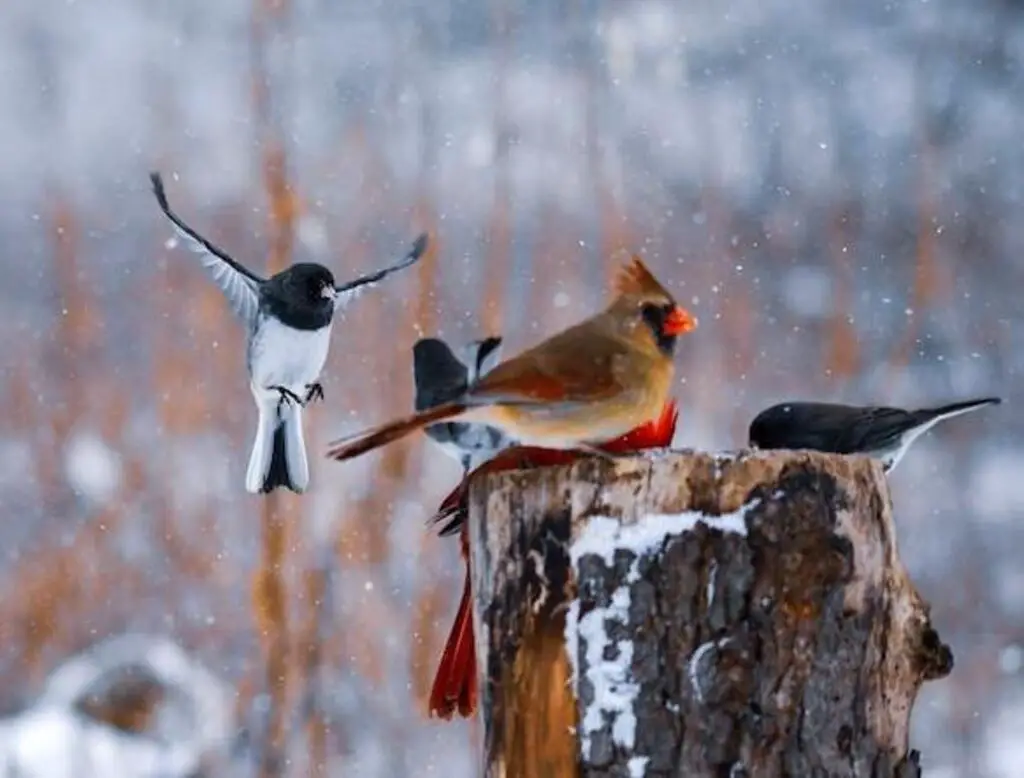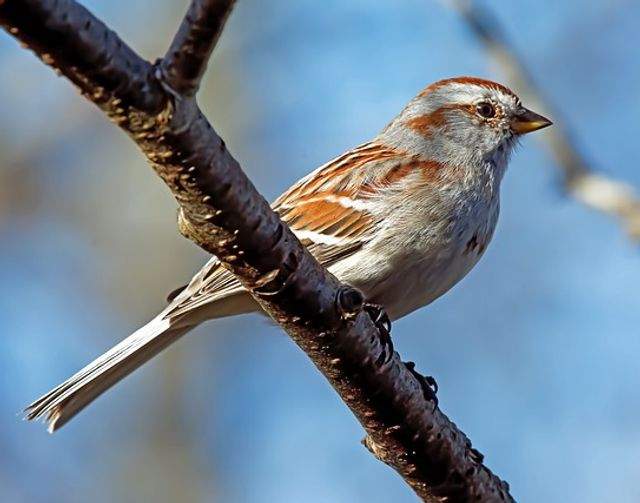Welcome to our expert guide on the 22 backyard winter birds in New York! As winter descends upon New York, it brings with it a diverse array of avian visitors to backyard feeders and habitats.
In this comprehensive guide, we’ll explore the fascinating world of New York’s winter birdlife, featuring 22 species commonly observed during the colder months.
From vibrant cardinals to agile chickadees, learn about their behaviors, habitats, and survival strategies in the face of winter’s challenges.
Whether you’re a seasoned birder or a newcomer to birdwatching, join us as we celebrate the beauty and resilience of New York’s backyard winter birds.
Table of Contents
- 1 Winter Birds in New York
- 1.1 Black-capped Chickadee
- 1.2 Northern Cardinal
- 1.3 Blue Jay
- 1.4 American Crow
- 1.5 Downy Woodpecker
- 1.6 Dark-eyed Junco
- 1.7 Mourning Dove
- 1.8 White-breasted Nuthatch
- 1.9 European Starling
- 1.10 House Sparrow
- 1.11 Tufted Titmouse
- 1.12 Red-bellied Woodpecker
- 1.13 American Goldfinch
- 1.14 White-throated Sparrow
- 1.15 House Finch
- 1.16 Song Sparrow
- 1.17 Rock Pigeon
- 1.18 Hairy Woodpecker
- 1.19 American Robin
- 1.20 American Tree Sparrow
- 1.21 Carolina Wren
- 1.22 Northern Mockingbird
- 2 Author
Winter Birds in New York
Black-capped Chickadee

- Length: 4.7-5.9 in (12-15 cm)
- Weight: 0.3-0.5 oz (9-14 g)
- Wingspan: 6.3-8.3 in (16-21 cm)
- Scientific Name: Poecile atricapillus
- Frequency of Occurrence: 42.42% (Statistic by: eBird)
- Where To Find Them: The Black-capped Chickadee is a common bird found in many locations in New York. They can be found throughout the state in winter, but are most commonly seen in the Catskill Mountains and around Rochester.
- How to Attract Them: There are many ways to attract the Black-capped Chickadee to your yard or garden. One way is to provide plenty of food, such as sunflower seeds, and suet. Another way is to make a nest for the bird in a tree near your property.
General Information: The black-capped chickadee (Parus atricapillus) is a widespread bird found in North America. The chickadee is found in the eastern and central United States, as well as parts of southern Canada. This species primarily inhabits open woodlands and thorny shrubbery, but has also been documented in urban areas.
The black-capped chickadee is typically a gregarious bird and forages for food throughout the day. The chickadee feeds mostly on insects, but will also eat seeds, fruits and berries. The males typically sing for their mates during the breeding season.
Handpicked Related Post: Unique Black-capped Chickadee Facts You Need To Know!
Northern Cardinal

- Length: 8.3-9.1 in (21-23 cm)
- Weight: 1.5-1.7 oz (42-48 g)
- Wingspan: 9.8-12.2 in (25-31 cm)
- Scientific Name: Cardinalis cardinalis
- Frequency of Occurrence: 38.43%
- Where To Find Them: They can generally be found in locations such as the Bronx, Brooklyn, and Manhattan during winter.
- How to Attract Them: Place a sunflower or safflower seed feeder in an area where they are commonly seen. Add a birdbath to your yard or garden for these birds to use as a bathing spot. Plant a variety of Bird’s Foot Trefoil near your birdbath to provide them with nectar and pollen. Make sure you have plenty of nesting material nearby, such as branches and twigs from nearby trees, shrubs, or even fence posts.
General Information: The Northern Cardinal is a common songbird in North America and can be found throughout the eastern and central United States. The cardinal’s distribution range extends throughout much of Canada, as well as most of the northern United States. The cardinal feeds primarily on insects, but will also consume seeds, berries, and fruit.
Nests are built in trees or on vines, shrubs or low trees and are composed of a few layers of soft materials such as feathers, down, and plant matter. Cardinals typically lay 3-5 eggs, which are incubated for 11-13 days by the female.
Handpicked Related Post:
- 10 Best Bird Feeders for Cardinals (Rated for 2022)
- Best Birdhouse for Cardinals 2022 (Tested And Rated)
- Cardinal Bird Facts Every Birdwatcher Should Know!
Blue Jay

- Length: 9.8-11.8 in (25-30 cm)
- Weight: 2.5-3.5 oz (70-100 g)
- Wingspan: 13.4-16.9 in (34-43 cm)
- Scientific Name: Cyanocitta cristata
- Frequency of Occurrence: 37.70%
- Where To Find Them: They can be found in the suburbs and cities of New York, including Long Island and Upstate New York.
- How to Attract Them: If you’re looking to attract blue jays to your yard, it’s important to provide them with plenty of birdfeed and habitat. Sunflower seeds, nuts, and safflower seeds are all great choices; just be sure to place the feed in a birdbath or other area that the blue jays will frequent. Additionally, trees can provide shelter from the weather as well as food and nesting sites for birds.
General Information: The range of the Blue Jay is broad, spanning from the southeastern United States all the way to central Mexico. They are common in most areas of North America, and can be found in rural and urban areas. The Blue Jay prefers open woodland but can also be found near human habitation.
They feed mainly on insects and other small creatures, but will also eat fruits and grains, nuts and seeds. The Blue Jay nests in trees, usually 10-25 feet above the ground. They typically lay 2-7 eggs which are incubated by the female for about 18 days.
Handpicked Related Post:
- 15 Best Bird Feeders For Blue Jays (Tried & Tested 2022)
- What Attracts Blue Jays to your Yard?(Expert Tips)
- What Does A Blue Jay Eat? (10 Favorite Foods Revealed!)
- What does a Blue Jay look like? Tips to identify them!
American Crow

- Length: 15.8-20.9 in (40-53 cm)
- Weight: 11.2-21.9 oz (316-620 g)
- Wingspan: 33.5-39.4 in (85-100 cm)
- Scientific Name: Corvus brachyrhynchos
- Frequency of Occurrence: 35.73%
- Where To Find Them: The American crow can be found throughout most of New York, but they are especially common in Central and Western New York. They can also be found in locations near the Canadian border, such as Buffalo and Rochester. In winter, American crows tend to congregate around large bodies of water, like reservoirs and lakes.
- How to Attract Them: Sunflower seeds, nuts, and safflower seeds are some of the foods that they like to eat. Water sources can also be helpful in attracting American crows. Trees are also important because they provide shelter for the crows and other birds.
General Information: The American Crow is a common bird in North America. The distribution range of this crow is from the eastern seaboard of the United States to the prairies of central Canada. It also ranges south to Florida, and west to Texas. American Crows are usually found in open areas with plenty of food sources, such as fields, forests, and parks.
They also like to live near water sources. American Crows are omnivorous and eat a variety of foods, including insects, other small animals, grains, seeds, nuts, berries and fruits. They build their nests out of sticks and other materials.
Handpicked Related Post:
Downy Woodpecker

- Length: 5.5-6.7 in (14-17 cm)
- Weight: 0.7-1.0 oz (21-28 g)
- Wingspan: 9.8-11.8 in (25-30 cm)
- Scientific Name: Picoides pubescens
- Frequency of Occurrence: 34.20%
- Where To Find Them: Downy Woodpeckers can be found in a variety of locations and areas in New York in winter. Some good spots include the Catskill Mountains, the Adirondacks, and the Mohawk Valley.
- How to Attract Them: Downy Woodpeckers are a favorite bird of many people. For those who want to attract them to their yard, there are some things that can be done. Black oil sunflower seeds can be fed to the birds as they will appreciate the nutritional value in them. Millet is another good food for these birds as it is high in fiber and other nutrients. Peanuts can also be offered as a snack, and chunky peanut butter can make a great addition to their diet.
General Information: The Downy Woodpecker is a widespread North American woodpecker. It ranges from the Canadian Arctic to Central America, and from the eastern United States to western Venezuela. The Downy Woodpecker is found in deciduous and mixed forests, as well as in orchards and gardens.
It also frequents some suburban areas. The diet of the Downy Woodpecker includes insects, especially ants, beetles, larvae, caterpillars, and spiders, but will also feed on berries, acorns, and grains . The Downy Woodpecker nests in cavities in trees, most commonly near water.
Handpicked Related Post: How to Attract Downy Woodpeckers to Your Yard? (Easy!)
Dark-eyed Junco
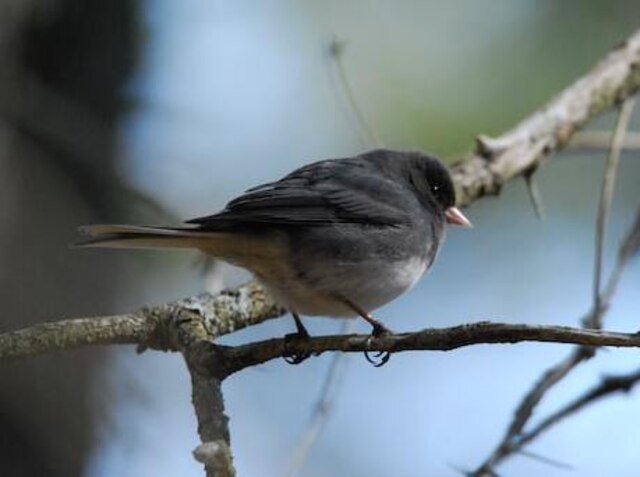
- Length: 5.5-6.3 in (14-16 cm)
- Weight: 0.6-1.1 oz (18-30 g)
- Wingspan: 7.1-9.8 in (18-25 cm)
- Scientific Name: Junco hyemalis
- Frequency of Occurrence: 33.41%
- Where To Find Them: In winter, they can be found in areas near the Hudson River, such as Westchester County and Cold Spring Harbor.
- How to Attract Them: If you are looking to attract a dark-eyed junco, you will want to try scattering hulled sunflower seeds around your yard. These small seeds will provide the bird with a good source of sustenance. You can also try feeding white proso millet to the birds, as it is a high-quality food that they will enjoy. Finally, you can give your birds some cracked corn as a treat.
General Information: The Dark-eyed Junco is a common bird found in North America. It has a distribution range that extends from the southern United States to north central Canada. The Dark-eyed Junco inhabits open areas such as prairies, meadows, and wetlands.
It is an omnivore that consumes a variety of food items, including insects, seeds, nuts, grains and small fruits. The Dark-eyed Junco nests in cavities in trees or creates depressions on the ground. The nest is made of twigs, leaves, and other simple materials.
Handpicked Related Post: Fun Facts About Dark-eyed Juncos
Mourning Dove

- Length: 9.1-13.4 in (23-34 cm)
- Weight: 3.4-6.0 oz (96-170 g)
- Wingspan: 17.7 in (45 cm)
- Scientific Name: Zenaida macroura
- Frequency of Occurrence: 30.60%
- Where To Find Them: Mourning doves are a common sight in many areas of New York in winter. They can be found in most major metropolitan areas, but they are especially numerous in the Central Park area and near the Statue of Liberty. In Central Park, there are several large wooded areas where they can be seen feeding on seed and insects.
- How to Attract Them: Here is what you need to put in a mourning dove feeder: Shelled sunflower seeds are good because they are high in protein and essential fatty acids. Nyjer is a type of seed that mourning doves love, so make sure to include some in your feeder. Cracked corn is also a favorite of these birds, so be sure to add some in there as well. Finally, add some peanuts for fun.
General Information: Mourning doves are found throughout North America. The distribution range of this bird stretches from the Arctic tundra to the tropics. Mourning doves inhabit a variety of habitats, from open fields and meadows to woodlands and wetlands.
They mainly eat seeds, grasses, weeds, grains, nuts, berries and some small animals, but will also consume some vegetable matter. Nests are built in tree cavities, often near water. These birds typically lay 2 eggs per clutch, but may lay up to 4 eggs in severe cases.
Handpicked Related Post: Facts About Mourning Doves – 10 Things You Need To Know!
White-breasted Nuthatch
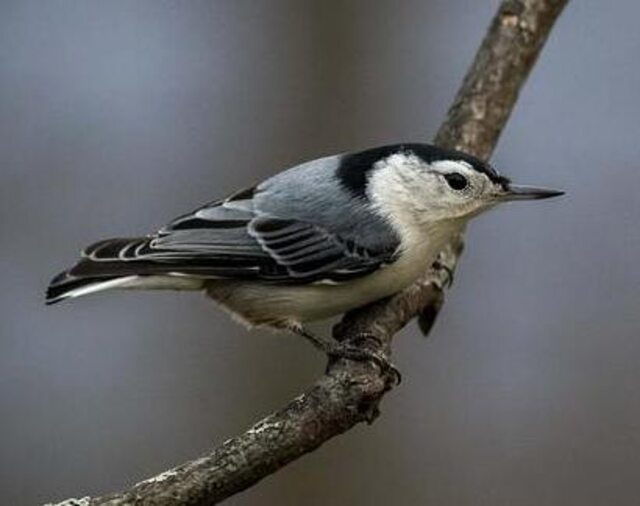
- Length: 5.1-5.5 in (13-14 cm)
- Weight: 0.6-1.1 oz (18-30 g)
- Wingspan: 7.9-10.6 in (20-27 cm)
- Scientific Name: Sitta carolinensis
- Frequency of Occurrence: 28.32%
- Where To Find Them: In winter, they can be found in locations such as the Adirondacks and the Catskills.
- How to Attract Them: To attract this bird to your yard, try supplying them with sunflower seeds and peanuts. These two items provide a good balance of nutrients and will keep them healthy.
General Information: The white-breasted nuthatch is a common bird in the eastern United States. It ranges from southern New Hampshire and Maine south to Florida and west to Texas. The white-breasted nuthatch inhabits a variety of habitats, including deciduous and mixed woods, suburban gardens, orchards, and even Second growth forests.
It feeds on insects, especially caterpillars, but also seeds and small fruits. Nests are typically in trees, but they have been seen constructing nests on the ground as well.
Handpicked Related Post: How to Attract Nuthatches to your Backyard? Expert Tips!
European Starling
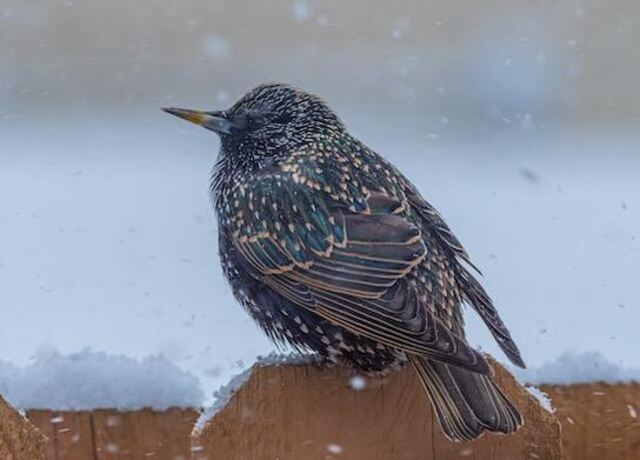
- Length: 7.9-9.1 in (20-23 cm)
- Weight: 2.1-3.4 oz (60-96 g)
- Wingspan: 12.2-15.8 in (31-40 cm)
- Scientific Name: Sturnus vulgaris
- Frequency of Occurrence: 27.56%
- Where To Find Them: The European Starling is a common bird found in many locations in New York, including Central Park and the Hudson Valley. They can also be found in areas near the ocean, such as Long Island Sound or salt marshes.
- How to Attract Them: Plant sunflower seeds in your yard. European starlings love sunflower seeds and will come to feed on them regularly. Feed suet to the birds. This will give them a good source of energy and help keep them healthy.
General Information: European starlings are a common, widespread bird in most parts of the world. They are found in most countries in Europe, except for Iceland and Norway. They also occur in Africa, Asia, North America and South America. The distribution range of European starlings is very large, covering an area from the Arctic to the Mediterranean Sea.
European starlings are usually found in open areas such as parks, gardens and farmland. They eat a variety of things including insects, spiders, worms, seeds, grains, fruits, berries and even garbage. They build their nests out of sticks and other materials and lay two or six eggs per clutch.
Handpicked Related Post: How To Attract European Starlings To Your Yard Fast?
House Sparrow
- Length: 5.9-6.7 in (15-17 cm)
- Weight: 0.9-1.1 oz (27-30 g)
- Wingspan: 7.5-9.8 in (19-25 cm)
- Scientific Name: Passer domesticus
- Frequency of Occurrence: 25.95%
- Where To Find Them: In New York City, the house sparrow can be found in locations such as Central Park and Riverside Park. In winter, they can also be found in areas such as the Bronx Zoo and Fordham University.
- How to Attract Them: House Sparrows are a common bird in many areas of the world, but they can be difficult to attract to your yard. Here are some tips for attracting them: – Provide a variety of food sources, including seeds, fruit, and insects. – Install a perch or platform for the birds to rest on. – Hang bird feeders high in trees or poles. – Make sure your yard is clean and well-maintained.
General Information: The house sparrow is a common resident in many parts of North America. The distribution range of the house sparrow extends across most of the continent, though it is absent from the extreme north and south. In general, the house sparrow prefers to live near humans, though it will also inhabit areas with dense vegetation or in protected locations.
The house sparrow feeds mainly on seeds, but will also eat insects, grains, seeds and garbage. They build their nests out of small twigs, paper, feathers, string and leaves, for the lining and typically lay 2-8 eggs.
Handpicked Related Post: How to Attract Sparrows to your Backyard? (Like A Pro)
Tufted Titmouse

- Length: 5.5-6.3 in (14-16 cm)
- Weight: 0.6-0.9 oz (18-26 g)
- Wingspan: 7.9-10.2 in (20-26 cm)
- Scientific Name: Baeolophus bicolor
- Frequency of Occurrence: 25.85%
- Where To Find Them: They can be found throughout most of the city, but they are especially common in Central Park and around Prospect Park. They like to live near trees and shrubs, and are often seen hopping around looking for food. In winter, they often move into sheltered areas such as attics or garages.
- How to Attract Them: The tufted titmouse is a small bird that is easy to attract with the right feeder. Here are some tips on how to attract them:Tufted titmice like to eat small seeds and nuts, so offer them a feeder full of these items. They will also enjoy birdseed, but make sure it is fresh and not old or moldy. Hang a small object near the feeder that the titmice can perch on. This could be a branch, pole, or wire mesh toy. Place some fresh fruit in the vicinity of the feeder for the birds to eat. Apples, grapes, and other fruits are all good choices. Keep your garden clean and free of debris so that the titmice have plenty of places to nest and feed their young.
General Information: The tufted titmouse is a small passerine bird that inhabits a wide range of habitats in North America. It is found from the eastern United States and Ontario to western Texas, the Mexican state of Baja California, and the southwestern corner of California. It also ranges into central Chile.
Tufted titmice are usually found in open woodlands and forest edge, but they can also be found near human settlements. They forage on the ground or in low shrubs for insects, spiders, and other small prey as well as seeds. They build simple nests of grass, hair, and other materials on high branches or trees. The breeding season starts in the spring and carries on with July.
Handpicked Related Post: How to Attract Tufted Titmouse to my Yard? (Explained)
Red-bellied Woodpecker
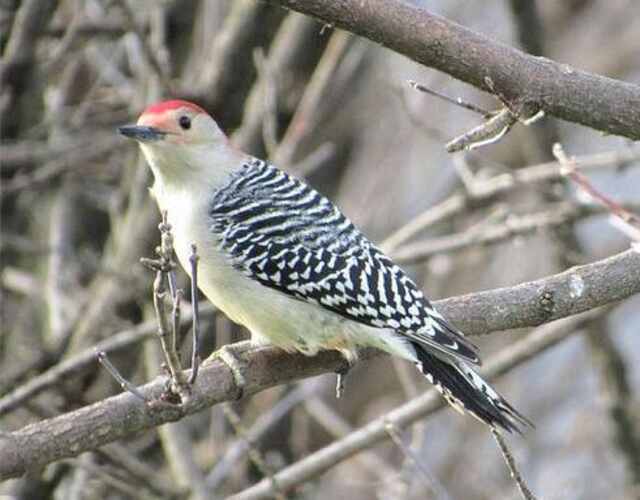
- Length: 9.4 in (24 cm)
- Weight: 2.0-3.2 oz (56-91 g)
- Wingspan: 13.0-16.5 in (33-42 cm)
- Scientific Name: Melanerpes carolinus
- Frequency of Occurrence: 24.67%
- Where To Find Them: They can be found in many different locations, but some of the more popular ones include Central Park and Riverside Park.
- How to Attract Them: If you’re looking to attract the red-bellied woodpecker, keep in mind that this bird is territorial. Make sure to create a well-rounded environment for them to live in, including plenty of trees and shrubs. You can also try creating a bird feeder or adding birdhouses to your property.
General Information: The Red-bellied Woodpecker is found in a vast area of the United States, from southern Canada to central Mexico. It inhabits open woodlands and mixed forests, as well as suburban and rural areas. The bird is most common in the east and southeast, but can also be found in most parts of the country.
The Red-bellied Woodpecker feeds on insects, especially ants, larvae, beetles, and caterpillars. It builds its nest in tree cavities, that they excavate, and will lay their eggs on wood chips.
Handpicked Related Post: How to Attract Red-bellied Woodpeckers to your Yard?
American Goldfinch

- Length: 4.3-5.1 in (11-13 cm)
- Weight: 0.4-0.7 oz (11-20 g)
- Wingspan: 7.5-8.7 in (19-22 cm)
- Scientific Name: Spinus tristis
- Frequency of Occurrence: 24.10%
- Where To Find Them: American Goldfinch can be found in locations or areas in New York in winter. Some of these locations include the Central Park and Prospect Park areas.
- How to Attract Them: In winter, one of the easiest ways to attract American Goldfinches is to provide black-oil sunflower seeds in your bird feeder.
General Information: The American Goldfinch is a small yellow and black bird that ranges across much of North and Central America. The distribution range of the American Goldfinch includes most of the United States, southern Canada, and extreme northern Mexico.
This bird inhabits woodlands, gardens, and other areas with scattered trees or shrubs. The diet of this bird consists mainly of seeds, but it will also occasionally consume insects. American Goldfinch nests in high in shrubs, beginning in July and ending in September.
Handpicked Related Post: Interesting American Goldfinch Facts You Need to Know!
White-throated Sparrow
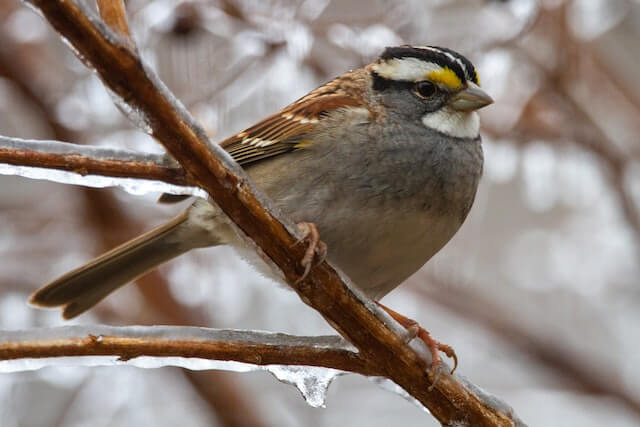
- Length: 6.3-7.1 in (16-18 cm)
- Weight: 0.8-1.1 oz (22-32 g)
- Wingspan: 7.9-9.1 in (20-23 cm)
- Scientific Name: Zonotrichia albicollis
- Frequency of Occurrence: 23.29%
- Where To Find Them: The white-throated sparrow is a common bird found in most of North America during the winter. They can be found in locations or areas throughout New York including Long Island and the Hudson Valley. They prefer open areas with plenty of trees, but can also be found in large urban parks.
- How to Attract Them: White-throated Sparrows are a common visitor to bird feeders during the winter. But how do you attract them? One way is to set up a feeder with multiple food sources, including sunflower seed, thistle seed, cracked corn, safflower seed, or white proso millet . Another way is to hang a bird bath full of fresh water. Finally, make sure your feeder is placed in an area where they can see it from a distance.
General Information: The White-throated Sparrow is a common resident of most of North America. It is found in all but the coldest parts of the continent. It breeds in most of the United States, eastern Canada, and northern Mexico, and winters in Central America and South America. The Sparrow is also common to migrant in much of its range and occurs as far north as Alaska and extreme southern Louisiana.
The Sparrow’s preferred habitats are open woods with plenty of trees for perching, well-watered areas such as gardens or pastures, or even large urban parks. In winter it will often use open buildings such as schools or churches. The Sparrow eats a variety of insects, seeds, berries, and other small animals.
House Finch
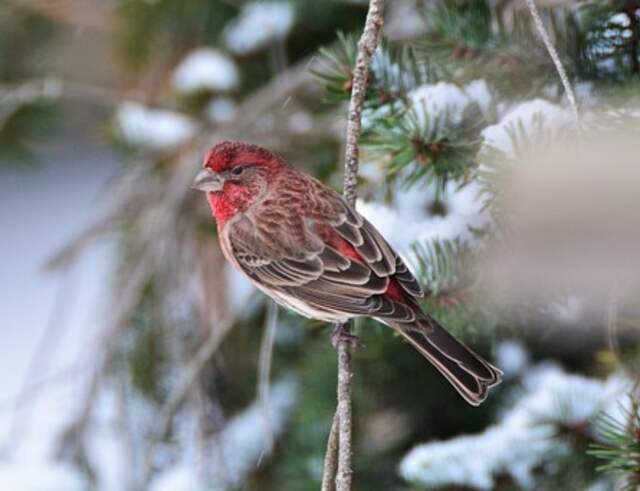
- Length: 5.1-5.5 in (13-14 cm)
- Weight: 0.6-0.9 oz (16-27 g)
- Wingspan: 7.9-9.8 in (20-25 cm)
- Scientific Name: Haemorhous mexicanus
- Frequency of Occurrence: 17.54%
- Where To Find Them: House Finches can be found in a variety of locations throughout New York in winter. Some popular locations include Central Park, Riverside Park, and Prospect Park. These finches are often seen perched on telephone wires or the tops of trees.
- How to Attract Them: Provide food sources like black-oil sunflower seed or suet can also help lure them in. If you live in an area with cold winters, be sure to provide plenty of shelter for your feathered friends. Birdhouses protected by snow or ice can provide much-needed warmth, while providing a safe place for them to roost during the day.
General Information: House finches are a group of small passerine birds that make up the family Fringillidae.These small birds are distributed throughout most of Canada, south to central Mexico, throughout much of Central America, and into parts of South America. They inhabit a wide variety of habitats including urban areas, rural gardens, and heavily forested areas.
House finches diet consists mainly of seeds, grains and berries, but they also consume the occasional aphid. They build nests from mud, plant materials, or feathers and lay 2-4 eggs. House finches are common inhabitants of parks and gardens, where they can be seen foraging for food or roosting on buildings.
Handpicked Related Post: How to Attract House Finch to your Yard? (Easy & Fast)
Song Sparrow
- Length:4.7-6.7 in (12-17 cm)
- Weight: 0.4-1.9 oz (12-53 g)
- Wingspan: 7.1-9.4 in (18-24 cm)
- Scientific Name: Melospiza melodia
- Frequency of Occurrence: 15.37%
- Where To Find Them: The song sparrow is a small bird that can be found in locations all over New York in winter. They can be found in areas such as Central Park, the Bronx Zoo, and the Brooklyn Botanical Gardens. In Central Park, they are common around the Mall and in the Conservatory Garden. The Bronx Zoo has a large population of song sparrows, and they are often seen on lawns and near water features. The Brooklyn Botanical Gardens have a large population of song sparrows, as well as other smaller birds.
- How to Attract Them: Plant a variety of seeds for songbirds, such as sunflower and cracked corn. These will be high in energy and will provide a varied diet for the sparrows.
General Information: The song sparrow is a small bird that ranges across North America. This passerine is most common in the eastern United States, but it can also be found in Canada and Mexico. The song sparrow is a migratory bird, traveling long distances to find new areas to live and breed.
The song sparrow prefers open spaces such as meadows and prairies, but will also inhabit woodlands and urban areas. The song sparrow primarily eats insects, but it will also consume some seeds and fruit. It nests in holes or cavities in trees or buildings, and typically has two to six eggs, which are incubated by the female alone for about 15-17 days.
Rock Pigeon
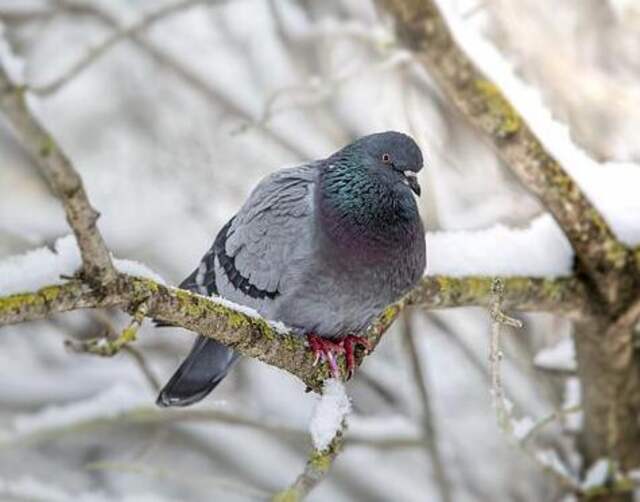
- Length:11.8-14.3 in(30-36 cm)
- Weight: 9.3-13.4 oz (265-380 g)
- Wingspan: 19.7-26.5 in (50-67 cm)
- Scientific Name: Columba livia
- Frequency of Occurrence: 15.14%
- Where To Find Them: Rock pigeons are a common sight in New York City during the winter. They can be found in many areas, but some of the most popular locations include Central Park and Prospect Park. These birds are attracted to cold environments and can often be seen perched on high buildings or bridges.
- How to Attract Them: Now is the time of year when rock pigeons are most likely to be seen. If you want to attract them, offer them a food source that they’re likely to enjoy in wintertime – sunflower seeds and safflower seeds are both good choices. You can also give them peanuts as a treat.
General Information:The rock pigeon is a medium-sized pigeon that is found throughout much of North America. It is a common sight in both rural and urban areas, as well as in many open spaces. The rock pigeon is a migratory bird, and it ranges from the central United States to the northernmost parts of Canada.
Rock pigeons feed mainly on seeds, but they also eat insects and other small animals. They nest in holes in rocks, cliffs, overhangs, or usually choosing locations near water. Rock pigeons generally lay one or three eggs per year.
Handpicked Related Post: Birds that look like Pigeons (Photos, ID & Stats)
Hairy Woodpecker
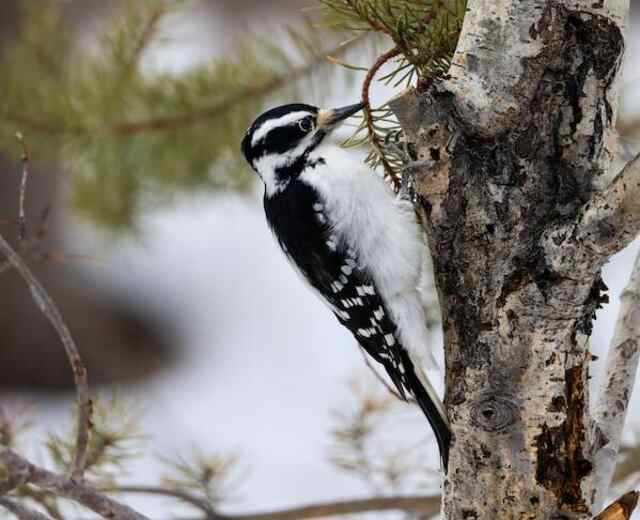
- Length: 7.1-10.2 in (18-26 cm)
- Weight: 1.4-3.4 oz (40-95 g)
- Wingspan: 13.0-16.1 in (33-41 cm)
- Scientific Name: Leuconotopicus villosus
- Frequency of Occurrence: 14.16%
- Where To Find Them: The Hairy Woodpecker is a common bird found in many locations around New York, including in the Bronx, Brooklyn, and Queens. They can also be found in winter in areas near rivers and lakes.
- How to Attract Them: Hairy Woodpeckers are one of the most popular bird species to watch in wintertime. They are attracted to various suet baits, peanut butter, and black oil sunflower seeds. Some people also like to place a few pieces of fresh fruit near their feeder.
General Information: The Hairy Woodpecker is a small, stout woodpecker that is found in the eastern and central United States. It is a common bird in many areas, but is rare in some. The Hairy Woodpecker distribution range extends from New England and Ohio in the north to Florida and Texas in the south. The bird inhabits mixed deciduous and hardwood forests, as well as orchards and gardens.
It feeds on insects, especially beetles, larvae, ants, termites, spiders, wasps, caterpillars, spiders, millipedes, but also takes fruit and seeds when available. Nests are excavated in a dead tree stub, with the female laying three to six eggs on a bed of wood chips. Eggs are then incubated for up to 12 days.
American Robin

- Length: 7.9-11.0 in (20-28 cm)
- Weight: 2.7-3.0 oz (77-85 g)
- Wingspan: 12.2-15.8 in (31-40 cm)
- Scientific Name: Turdus migratorius
- Frequency of Occurrence: 14.03%
- Where To Find Them: In winter, they can be found in locations including upstate New York, the Adirondacks, and downstate New York.
- How to Attract Them: If you’re looking to attract American Robins in wintertime, consider using a platform feeder. These feeders hold food above the ground, making it more accessible to the birds. Also make sure to put out some mealworms, which the robins love!
General Information: American Robins are a common bird found throughout much of North America. They occupy a wide range, from the frosty tundra of the north to the hot, dry deserts of the south. American Robins prefer open areas with plenty of vegetation, such as meadows and fields. In winter, they often forage for food in trees or on the ground. Their diet consists mainly of insects such as earthworms and other small creatures.
American Robins typically nest in large colonies, often selecting old buildings or other elevated sites. The female builds a soft cup-shaped nest out of straw, feathers, and other materials. She lays two to four eggs and both parents care for the chicks until they fledge about six weeks later.
Handpicked Related Post:
- How To Attract Robins To Your Yard – 7 Best Tips!
- 5 Best Bird Feeders For Robins (Tested & Rated For 2022)
- 9 Birds That Look Like Robins But Aren’t (Photos, & Info)
- Interesting American Robin Fun Facts (Explained)
American Tree Sparrow
- Length: 5.5 in (14 cm)
- Weight: 0.5-1.0 oz (13-28 g)
- Wingspan: 9.4 in (24 cm)
- Scientific Name: Spizelloides arborea
- Frequency of Occurrence: 13.00%
- Where To Find Them: American Tree Sparrows can be found in a variety of locations in New York, including downtown areas and parks. In winter, they can be found in areas that have large expanses of open space, such as Central Park. They are also attracted to bird feeders, so it is important to keep an eye on them and provide enough food for them to stay healthy.
- How to Attract Them: One way to attract American Tree Sparrows in winter is to provide them a bird feeder with sunflower and safflower seeds. These seeds are high in energy and will help keep the birds happy and healthy during the cold months.
General Information: The American Tree Sparrow is a common bird in most parts of North America. It is found throughout the eastern and central United States as well as in southern Canada. The American Tree Sparrow’s distribution range extends east to the Great Lakes Region and west to the Rocky Mountains.
Its habitat includes open areas such as farmland, forest edges, parks, and gardens. The American Tree Sparrow is an omnivorous bird that eats a variety of food items including insects, seeds, and fruit. It nests in tall trees or on ledges.
Handpicked Related Post: 10 Fascinating American Tree Sparrow Facts
Carolina Wren
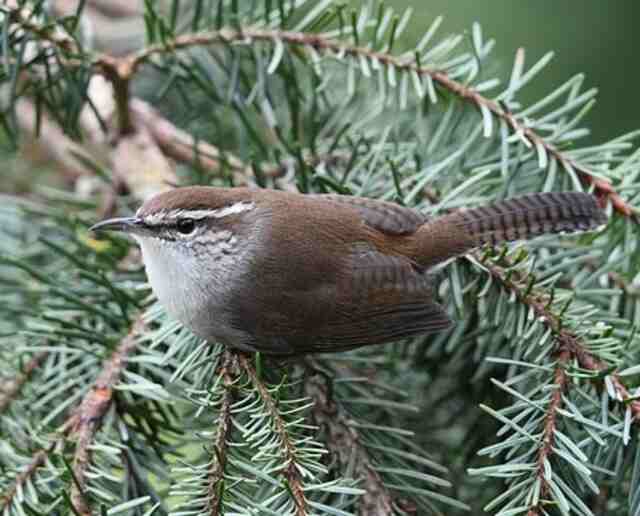
- Length: 4.7-5.5 in (12-14 cm)
- Weight: 0.6-0.8 oz (18-22 g)
- Wingspan: 11.4 in (29 cm)
- Scientific Name: Thryothorus ludovicianus
- Frequency of Occurrence: 11.45%
- Where To Find Them: Carolina wrens are a common bird in New York during winter. They can be found in many locations, including Central Park, the Hudson River Valley, and the Adirondacks.
- How to Attract Them: Sunflower seeds are a great way to attract Carolina Wrens in winter time. Suet or peanut butter can also be a tasty treat for these birds, as well as mealworms.
General Information: The Carolina Wren is a small, sparrow-sized bird that ranges throughout the eastern and central United States. The Carolina Wren is most commonly found in woodlands and suburban areas, but can also be found in open fields and rural areas.
The Carolina Wren primarily eats insects and other small animals, but will also consume seeds, berries, and other plant matter. Nests are built in open cavities, out of sticks, twigs, grasses, and leaves. Eggs are incubated by the female alone for 13-15 days.
Handpicked Related Post: How to Attract Wrens to your Backyard? (Expert’s Guide)
Northern Mockingbird
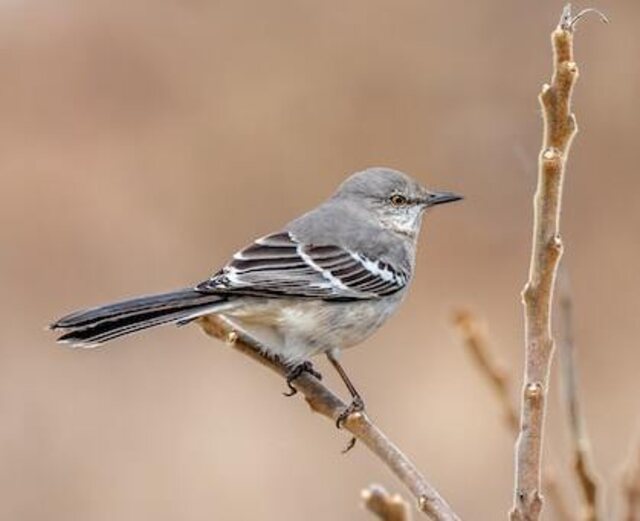
- Length:8.3-10.2 in (21-26 cm)
- Weight: 1.6-2.0 oz (45-58 g)
- Wingspan: 12.2-13.8 in (31-35 cm)
- Scientific Name: Mimus polyglottos
- Frequency of Occurrence: 9.46%
- Where To Find Them: Northern Mockingbirds can be found in many locations throughout New York State. In the Adirondacks, they are commonly found near lakes and reservoirs. They can also be found in the Mohawk Valley in Western New York, and around Syracuse and Ithaca. In the Bronx, they are common near woodlands and parks. In Upstate New York, they can be found in the Finger Lakes region and around Binghamton.
- How to Attract Them: Winter is a great time to attract Northern Mockingbirds to your bird feeder. A suet feeder with nuts and berry suet is the best option, as these birds love these kinds of foods. Halved peanuts are also a great choice, as they are a favorite food of this species. Mealworms can be added to the mix if you have them available.
General Information: The Northern Mockingbird is a common bird found throughout most of the United States. It is a migratory bird that spends its winters in South America and its summers in North America. The Northern Mockingbird’s distribution range spans from eastern Canada to west-central Mexico.
The Northern Mockingbird typically inhabits open areas such as fields, meadows, and pastures. Its diet consists mostly of insects and other small animals. The Northern Mockingbird nests in trees or on high perches.
Handpicked Related Post: How to Attract Mockingbirds to your Yard? (Expert Tips)
Related Post: Most Common Backyard Birds in New York (Explained)

